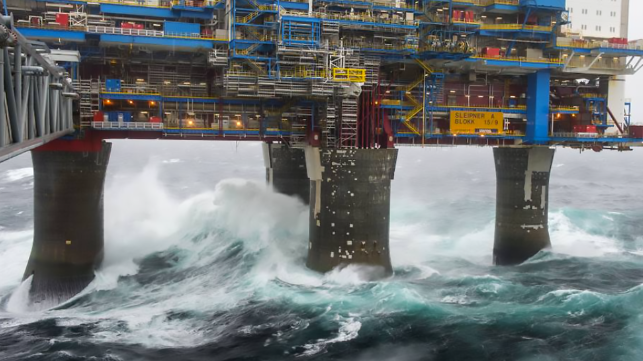How do Heavy Waves Affect Offshore Structures?

The force of waves slamming into offshore rigs, wind turbine pillars, ships or other offshore structures can do an enormous amount of damage.
One of the fundamental – and unresolved – problems with designing these kinds of large structures is being able to predict exactly how they will react to extreme stresses. What exactly is the load from the force of powerful waves slamming into structures?
Solving these challenges will be a major step towards safer and more cost-effective marine operations. “It’s crucial to understand the mutual interaction between the impacting wave and the response of the structure,” says Rene Kaufmann.
Kaufmann is a postdoctoral fellow at the NTNU SIMLab (Structural Impact Laboratory) and one of the researchers in the SLADE KPN project. This is a Knowledge-building Project for Industry (KPN) funded by the Research Council of Norway, in which researchers from SINTEF Ocean and NTNU are collaborating on basic research. The overall goal is to increase the safety at sea.
It’s important to expand what’s known about these challenges, but that will require systematic experimental studies of wave-impact scenarios. The project will do exactly that, which should allow researchers to figure out how a structure’s behaviour interacts with the loads that are applied to it.
The researchers are developing experimental methods to measure this interaction. Better calculation methods can help the industry when new offshore structures are designed.
Kaufmann’s focus is measuring the impact of local surface deformations from massive loads. One important aspect of his research is to make sure the measuring equipment itself doesn’t affect the structure’s properties. Researchers at SIMLab have used their experience with camera-based techniques to measure the structural response to loads from impacts and explosions.
But more on that later. First we’re heading out on a trip out into the Norwegian Sea.
“Huge wave on its way”
The monster horizontal waves that can slam violently against ships and other structures at sea originate from what are called 100-year storms.
In 1995, the offshore platform “Draugen” was put to a serious test at the Halten Bank area, on the Norwegian Continental Shelf. On March 12, a hurricane swept through the Norwegian Sea, and platform manager Magne Gundersen received an unexpected phone call from the Aberdeen Weather Center.
The Center warned of a massive wave on its way to the platform. The crew had only 30 minutes to prepare. Production was immediately stopped. Gundersen gathered the crew of 134 people into the gymnasium in the interior of the platform. There he reassured everyone by expressing his unconditional trust in the engineers who had designed the Draugen platform.

The Draugen platform on Halten Bank, in the Norwegian Sea. Photo: Svema / Creative Commons Attribution-Share Alike 4.0
“Just after I said those words, the loudest, most shivery and violent ‘BANG’ I have ever heard rang out,” Gundersen said in an interview after the incident. “We started to feel an increasingly large amont of movement under our feet. (…) [T]he room kept pitching. I couldn’t tell exactly how long it lasted but my guess would be more than a minute."
First the huge wave had hit the shaft, before it lifted itself up under the deck with tremendous force. The distance between the still water level to cellar deck of the platform is 30 metres.
Into the physics of wave slamming
A key question for SLADE is: What is the effective stress of these kinds of loads? “We have to understand the load before we can study the details of a structure’s behaviour,” says Vegard Aune, an associate professor at SIMLab.
Another incident that contributed to the motivation for SLADE occurred in the North Sea in December 2015, when a large, steep wave thundered into the COSL Innovator drilling rig. The platform was designed in accordance with regulations, but still failed to withstand the load. The incident took one human life and four people were injured. The rig was also extensively damaged.
“Accidents like the COSL Innovator event raise the question of whether we fully understand the underlying physics of loading during violent wave slamming. It’s crucial to provide construction engineers with detailed knowledge about loads, the underlying physics and the materials. All this is key to understanding and predicting how structures respond during extreme stress,” says Aune.
Kaufmann, along with fellow researchers Bjørn Christian Abrahamsen from SINTEF Ocean Transport & Energy and project engineers Trond Auestad (SIMLab) and Jens Åge Havmo (SINTEF Ocean), recently spent several days in the Ocean Basin Laboratory at Tyholt in Trondheim, where they conducted wave slamming tests on small-scale models. The researchers tested the measurement technique they had worked out, which involves measuring the load as the wave strikes the structure.
Today, this is measured with point meters that rely on wires. The SLADE team has been exploring the use of lasers and camera techniques that not only provide measurements at a given point, but can potentially determine in time and space how the entire incoming wave field evolves as it approaches the structure.
This development is leading to another goal for SLADE, that of bridging the gap between physical tests and reliable computer simulations.
The researchers recreated breaking waves in the basin, causing them to slam into a flat steel plate. The plate was integrated into a steel pillar representing a scaled-down steel structure at sea.
This article appears courtesy of Gemini News and is reproduced here in an abbreviated form. The original may be found here.
The opinions expressed herein are the author's and not necessarily those of The Maritime Executive.

